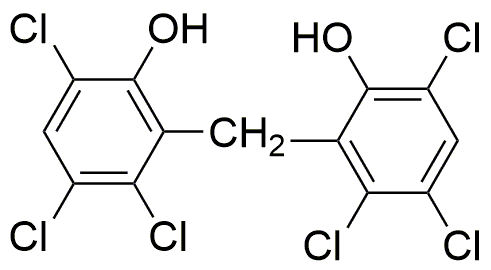Hexachlorophene is widely utilized in research focused on:
- Antiseptic Applications: Commonly used in medical settings, hexachlorophene serves as an effective antiseptic for skin disinfection, particularly in surgical environments, helping to reduce the risk of infections.
- Personal Care Products: This compound is incorporated into various personal care items, such as soaps and lotions, due to its antimicrobial properties, providing consumers with enhanced protection against bacteria.
- Industrial Cleaning Agents: Hexachlorophene is utilized in industrial cleaning formulations, especially for sanitizing surfaces in food processing and healthcare facilities, ensuring compliance with hygiene standards.
- Research in Microbiology: In laboratory settings, it is employed to study microbial resistance and the effectiveness of disinfectants, aiding researchers in developing better antimicrobial strategies.
- Historical Significance in Medicine: Once widely used in the treatment of skin infections, its historical application provides valuable insights into the evolution of antiseptic practices and the importance of safety regulations.
General Information
Properties
Safety and Regulations
Applications
Hexachlorophene is widely utilized in research focused on:
- Antiseptic Applications: Commonly used in medical settings, hexachlorophene serves as an effective antiseptic for skin disinfection, particularly in surgical environments, helping to reduce the risk of infections.
- Personal Care Products: This compound is incorporated into various personal care items, such as soaps and lotions, due to its antimicrobial properties, providing consumers with enhanced protection against bacteria.
- Industrial Cleaning Agents: Hexachlorophene is utilized in industrial cleaning formulations, especially for sanitizing surfaces in food processing and healthcare facilities, ensuring compliance with hygiene standards.
- Research in Microbiology: In laboratory settings, it is employed to study microbial resistance and the effectiveness of disinfectants, aiding researchers in developing better antimicrobial strategies.
- Historical Significance in Medicine: Once widely used in the treatment of skin infections, its historical application provides valuable insights into the evolution of antiseptic practices and the importance of safety regulations.
Documents
Safety Data Sheets (SDS)
The SDS provides comprehensive safety information on handling, storage, and disposal of the product.
Product Specification (PS)
The PS provides a comprehensive breakdown of the product’s properties, including chemical composition, physical state, purity, and storage requirements. It also details acceptable quality ranges and the product's intended applications.
Certificates of Analysis (COA)
Search for Certificates of Analysis (COA) by entering the products Lot Number. Lot and Batch Numbers can be found on a product’s label following the words ‘Lot’ or ‘Batch’.
*Catalog Number
*Lot Number
Certificates Of Origin (COO)
This COO confirms the country where the product was manufactured, and also details the materials and components used in it and whether it is derived from natural, synthetic, or other specific sources. This certificate may be required for customs, trade, and regulatory compliance.
*Catalog Number
*Lot Number
Safety Data Sheets (SDS)
The SDS provides comprehensive safety information on handling, storage, and disposal of the product.
DownloadProduct Specification (PS)
The PS provides a comprehensive breakdown of the product’s properties, including chemical composition, physical state, purity, and storage requirements. It also details acceptable quality ranges and the product's intended applications.
DownloadCertificates of Analysis (COA)
Search for Certificates of Analysis (COA) by entering the products Lot Number. Lot and Batch Numbers can be found on a product’s label following the words ‘Lot’ or ‘Batch’.
*Catalog Number
*Lot Number
Certificates Of Origin (COO)
This COO confirms the country where the product was manufactured, and also details the materials and components used in it and whether it is derived from natural, synthetic, or other specific sources. This certificate may be required for customs, trade, and regulatory compliance.


